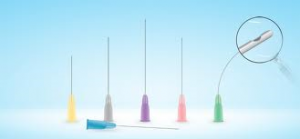
One area that microcannulas really excel is in the treatment of facial areas which are most concerning for pain and bruising. Injecting fillers into the tear troughs, lower eyelids and the lips with the use of microcannulas has become much more comfortable knowing the wide safety margin with a blunt-tipped device. While there is a very minor learning curve to their use, blunt tips allow one to ‘learn’ as much as needed in a patient without inflicting pain on them. While the skin still has to be penetrated by a needle to make an entry site through the skin for the microcannula to pass through, this is a very small scarifice to gain their benefits.
But microcannulas can be used for more than just injecting synthetic fillers. They can be equally useful for injecting local anesthestics in the office or for fully awake procedures, either in broad areas like for facial laser resurfacing or for lip or eyelid surgery. This makes the most difficult part of the procedure for the patient infinitely easier as well as virtually bruise-free. I just did a patient today who came in from out of town for a lip reduction and wanted to have it done under a local anesthestic. Injecting his upper and lower lips with a microcannula took away the most challenging part of the procedure both for him and for me!
The most interesting part of microcannulas to me is what took so long for the concept to be come clinically available. Fat has been extracted for decades by the use of large cannulas and the numbing and hemostatic solution to make it possible is infused with a much smaller cannula. I suspect this was an issue of the technology and machinery to do it. It is incredible that even done at the very small 30 gauge level a microcannula is available for use.
Dr. Barry Eppley
Indianapolis, Indiana


